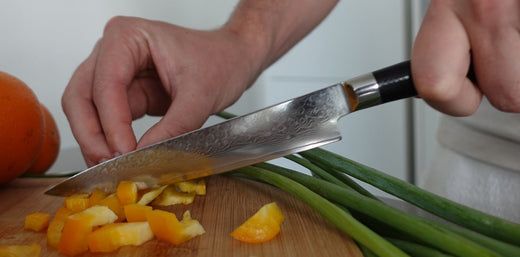The art of cooking requires effective and accurate tools. Among the essentials, we can count the utility knife, which is characterized by its versatility and practicality. Whether it's for amateur or professional use, this instrument deserves a prime place in your kitchen. Through this blog article, we will explore all the reasons why having a utility knife is essential in your kitchen, and why it would be relevant to invest in a Japanese utility knife.
The Versatility of the Utility Knife
The utility knife is generally considered a jack-of-all-trades in the kitchen. Larger than a paring knife, but smaller than a chef's knife, making it ideal for carrying out a multitude of tasks. Here are some of the most common uses:
-
Peeling and cutting vegetables:
With its intermediate size, the utility knife is perfect for peeling and cutting vegetables accurately. It is relatively handy for small tasks but is robust enough for more demanding tasks.
-
Meat Cutting :
Whether it's for slicing raw or cooked meat, the utility knife offers exceptional precision. Its blade is very thin, allowing it to make clean cuts without tearing the flesh.
-
Fruit Cutting :
For medium-sized fruits such as apples, pears or citrus fruits, the utility knife is a perfect tool. It allows you to peel, slice and cut fruit into pieces with ease.
The Advantages of the Utility Knife
Beyond its versatility, the utility knife presents several advantages that make it indispensable in the kitchen:
-
Maneuverability :
The size and weight of the utility knife make it easy to use. It is very light, which helps to avoid fatigue during long cutting sessions, while being strong enough for more complex tasks.
-
Precision :
The blade of the utility knife is in general, thinner than the blade of a chef's knife, allowing for more precise cuts. This feature is relatively useful for delicate tasks, such as making thin slices for fruits and vegetables.
-
Ease of maintenance :
Utility knives are often made of stainless steel, making them resistant to corrosion. This also makes them easy to maintain. Regular sharpening helps to keep the blade in excellent condition and guarantees optimal performance.
Why choose a Japanese knife?
Among the numerous options available on the market, the Japanese knife stands out for its exceptional quality and unique features. Here's why you should consider opt for a Japanese knife to add to your kitchen utensil collection:
-
Blade Quality :
Japanese knives are famous for their high-quality steel. The Japanese steel, often enriched with carbon, offers unique hardness, which allows maintaining a very fine and long-lasting edge. This feature is particularly appreciated for precision work in the kitchen.
-
Ergonomic Design :
Japanese knives are designed with specific attention to ergonomics. The handle can be made of wood, composite materials or resin, which offers a comfortable and safe grip. This design reduces fatigue when using and improves control.
-
Aesthetics and Tradition :
Japanese knives are high-performance tools and objects of art. Each knife is made with care, often following ancestral traditional methods passed down from generation to generation. Owning a Japanese knife is also to own a unique piece of craftsmanship.
Comparison between the Utility Knife and Other Kitchen Knives
It is essential to understand the differences between the utility knife and other kitchen knives to fully appreciate its value. Here is a brief comparison:
-
Chef's knife :
The chef's knife is larger and heavier than the utility knife. It is ideal for large cuts, such as slicing large pieces of meat or chopping large amounts of vegetables. However, its size can make it less practical for the precise tasks that the utility knife performs with ease.
-
Paring Knife :
The paring knife is smaller and lighter than the utility knife. It is perfect for peeling and cutting small fruits and vegetables. However, it lacks versatility for heavier tasks that the utility knife can handle without issue.
-
Bread Knife :
The bread knife is equipped with a serrated blade, ideal for slicing breads and pastries without crushing them. Unlike the utility knife, it is not designed for precise or versatile cutting.
How to choose the right utility knife?
Choosing the right utility knife depends on several factors, including your specific needs and your budget. Here are some tips to help you make the best choice:
-
Blade material :
Choose high-quality stainless steel or carbon steel blades for optimal durability and performance. Japanese knives in Damascus steel are also an excellent choice for their sharpness and aesthetics.
-
Ergonomics :
Make sure the knife offers a comfortable grip. Good ergonomics is essential to reduce fatigue and improve precision.
Conclusion
A utility knife is a valuable addition to any kitchen. Its versatility, maneuverability, and precision make it an indispensable tool for many culinary tasks. By choosing a Japanese knife, you not only benefit from the exceptional performance of Japanese steel but also the craftsmanship and unique aesthetic of Japanese knives.
Whether you are an amateur cook or a professional chef, a quality utility knife can transform your culinary experience, making each task easier and more enjoyable. Investing in a good utility knife is investing in your pleasure and efficiency in the kitchen.


6 Techniques to Know the Biggest Secrets of Japanese Cuisine
Discover the Art and Tradition of the Japanese Tea Ceremony